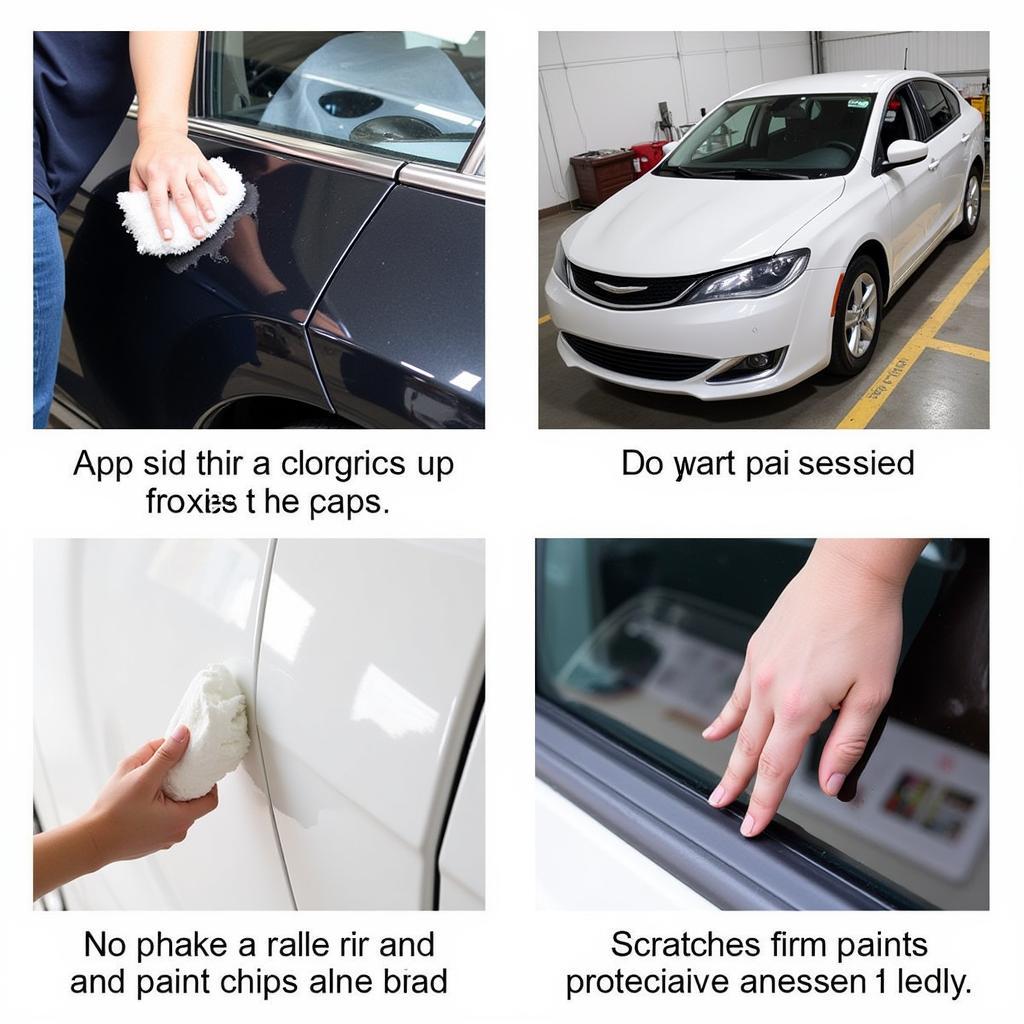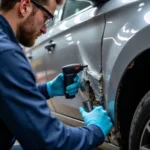Dealing with paint chips on your car can be frustrating. Whether it’s from a stray rock on the highway or a careless door ding in a parking lot, these small blemishes can detract from your car’s appearance and even lead to rust if left untreated. So, how do you tackle this common car problem effectively and efficiently? This guide will provide you with a step-by-step approach to repairing paint chips, from simple touch-ups to more involved repairs. We’ll explore different methods, offer expert tips, and help you decide on the best approach for your specific situation.
Finding a paint chip on your car can be annoying, but fixing it doesn’t have to be a major headache. For minor chips, a simple touch-up can work wonders. Larger chips might require a slightly more involved process, but with the right tools and techniques, you can achieve professional-looking results right in your own garage. Learn more about detailed car paint work at our car paint repair and detailing page.
Assessing the Damage: Types of Paint Chips
Before you start, it’s essential to assess the damage. Paint chips vary in size and depth, influencing the repair method you’ll need.
Minor Chips and Scratches
These are surface-level imperfections that haven’t penetrated the primer coat. They’re usually caused by minor impacts or scratches.
Medium Chips
These chips expose the primer but haven’t reached the bare metal. They require a bit more attention to prevent rust.
Deep Chips
These penetrate through the primer and expose the bare metal underneath. They require immediate attention to prevent rust and further damage.
How to Repair Minor Paint Chips
For minor chips, a simple touch-up paint application is often sufficient. Clean the area thoroughly with soap and water, then dry it completely. Apply a small amount of touch-up paint directly to the chip, using a fine-tipped brush or a toothpick. Allow the paint to dry completely before applying a second coat if necessary. You can find more information about repairing larger chips on our page dedicated to repair large car paint chips.
Repairing Medium and Deep Paint Chips: A Step-by-Step Guide
Dealing with medium and deep chips requires a more involved process.
-
Clean the Area: Clean the chipped area with soap and water, then use rubbing alcohol to remove any remaining grease or wax.
-
Sand the Area (if necessary): For deeper chips, lightly sand the area with fine-grit sandpaper to smooth any rough edges and create a better surface for the primer and paint to adhere to.
-
Apply Primer (if necessary): If the chip has reached the bare metal, apply a thin coat of automotive primer to prevent rust. Let it dry completely.
-
Apply Touch-Up Paint: Apply thin coats of touch-up paint, allowing each coat to dry before applying the next.
-
Sand and Level (if necessary): Once the paint is dry, you may need to lightly sand the area with very fine-grit sandpaper to level it with the surrounding paint.
-
Apply Clear Coat (optional): For a professional finish, apply a clear coat once the touch-up paint is completely dry.
Wondering about the costs involved? Check out our comprehensive guide on paint damage on car repair cost.
Finding the Right Touch-Up Paint
Finding the correct touch-up paint is crucial for a seamless repair. Your car’s owner’s manual should list the exact paint code. You can also usually find this code on a sticker located inside the driver’s side doorjamb.
Preventative Measures
Protecting your car’s paint can prevent future chips. Regular waxing, parking in covered areas, and using paint protection film are all effective preventative measures. Need car paint repair services in Nottingham? Visit our car paint repair nottingham page for more information. Or if you’re in Miami Gardens, Florida, our car repair paint usa miami gardens page can help you find local services.
 Preventative Car Paint Protection Measures
Preventative Car Paint Protection Measures
Conclusion: Keeping Your Car Looking Its Best
Repairing paint chips on your car doesn’t have to be a daunting task. With the right tools, techniques, and a bit of patience, you can restore your car’s finish and prevent further damage. By addressing paint chips promptly and taking preventative measures, you can keep your car looking its best for years to come. Remember, maintaining your car’s paintwork is an investment in its overall appearance and value.
FAQ
- Can I use nail polish to repair a paint chip?
- How long does touch-up paint take to dry?
- What grit sandpaper should I use for sanding paint chips?
- Do I need to apply a clear coat after touch-up paint?
- How can I prevent paint chips in the future?
- Where can I find my car’s paint code?
- Can I repair paint chips in direct sunlight?
Common Scenarios and Questions:
-
Scenario: Small rock chip on the hood.
-
Question: Can I just use touch-up paint?
-
Scenario: Deep scratch that exposes metal on the door.
-
Question: Do I need to apply primer before painting?
-
Scenario: Multiple chips along the side of the car.
-
Question: Should I consider professional repair?
Further Exploration:
For more information on related topics, you might find these articles helpful:
- How to remove scratches from car paint
- DIY car detailing tips
- Choosing the right car wax
Need assistance? Contact us via WhatsApp: +1(641)206-8880, or Email: [email protected]. Our customer support team is available 24/7.


